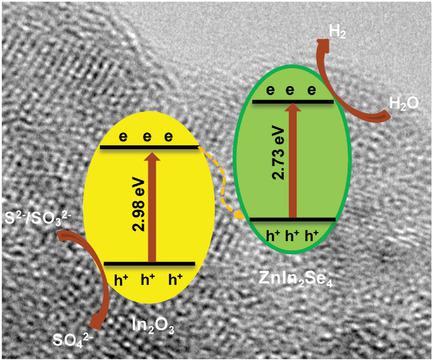当前位置:
X-MOL 学术
›
Adv. Mater.
›
论文详情
Our official English website, www.x-mol.net, welcomes your feedback! (Note: you will need to create a separate account there.)
Ultrathin Visible‐Light‐Driven Mo Incorporating In2O3–ZnIn2Se4 Z‐Scheme Nanosheet Photocatalysts
Advanced Materials ( IF 29.4 ) Pub Date : 2018-12-05 , DOI: 10.1002/adma.201807226 Yuguang Chao 1, 2, 3 , Peng Zhou 1 , Na Li 4 , Jianping Lai 1, 5 , Yong Yang 1 , Yelong Zhang 1 , Yonghua Tang 1 , Wenxiu Yang 1 , Yaping Du 6 , Dong Su 4 , Yisheng Tan 2 , Shaojun Guo 1, 5
Advanced Materials ( IF 29.4 ) Pub Date : 2018-12-05 , DOI: 10.1002/adma.201807226 Yuguang Chao 1, 2, 3 , Peng Zhou 1 , Na Li 4 , Jianping Lai 1, 5 , Yong Yang 1 , Yelong Zhang 1 , Yonghua Tang 1 , Wenxiu Yang 1 , Yaping Du 6 , Dong Su 4 , Yisheng Tan 2 , Shaojun Guo 1, 5
Affiliation

|
Inspired by natural photosynthesis, the design of new Z‐scheme photocatalytic systems is very promising for boosting the photocatalytic performance of H2 production and CO2 reduction; however, until now, the direct synthesis of efficient Z‐scheme photocatalysts remains a grand challenge. Herein, it is demonstrated that an interesting Z‐scheme photocatalyst can be constructed by coupling In2O3 and ZnIn2Se4 semiconductors based on theoretical calculations. Experimentally, a class of ultrathin In2O3–ZnIn2Se4 (denoted as In2O3–ZISe) spontaneous Z‐scheme nanosheet photocatalysts for greatly enhancing photocatalytic H2 production is made. Furthermore, Mo atoms are incorporated in the Z‐scheme In2O3–ZISe nanosheet photocatalyst by forming the MoSe bond, confirmed by X‐ray photoelectron spectroscopy, in which the formed MoSe2 works as cocatalyst of the Z‐scheme photocatalyst. As a consequence, such a unique structure of In2O3–ZISe–Mo makes it exhibit 21.7 and 232.6 times higher photocatalytic H2 evolution activity than those of In2O3–ZnIn2Se4 and In2O3 nanosheets, respectively. Moreover, In2O3–ZISe–Mo is also very stable for photocatalytic H2 production by showing almost no activity decay for 16 h test. Ultraviolet–visible diffuse reflectance spectra, photoluminescence spectroscopy, transient photocurrent spectra, and electrochemical impedance spectroscopy reveal that the enhanced photocatalytic performance of In2O3–ZISe–Mo is mainly attributed to its widened photoresponse range and effective carrier separation because of its special structure.
中文翻译:

掺有In2O3-ZnIn2Se4 Z-方案的超薄可见光驱动钼纳米片光催化剂
受自然光合作用的启发,新型Z方案光催化系统的设计对于提高H 2产生和CO 2还原的光催化性能非常有希望。然而,到目前为止,高效Z方案光催化剂的直接合成仍然是一个巨大的挑战。在此,证明了通过基于理论计算的In 2 O 3和ZnIn 2 Se 4半导体的耦合,可以构建有趣的Z方案光催化剂。在实验中,一类超薄In 2 O 3 -ZnIn 2 Se 4(表示为In 2 O 3)–ZISe)制备了可显着提高H 2产生光催化性能的自发Z方案纳米片光催化剂。此外,钼原子被并入在Z方案在2 ö 3 -ZISe纳米片的光催化剂通过形成钼 Se键,通过X射线光电子光谱法确认,其中,所述形成摩西2作品为Z方案光催化剂的助催化剂。因此,In 2 O 3 -ZISe-Mo的这种独特结构使其具有比In 2 O 3 -ZnIn 2 Se 4和In 2分别高21.7和232.6倍的光催化H 2析出活性。分别为2 O 3纳米片。此外,In 2 O 3 -ZISe-Mo对光催化H 2的生产也非常稳定,因为在16 h测试中几乎没有活性衰减。紫外可见漫反射光谱,光致发光光谱,瞬态光电流光谱和电化学阻抗光谱表明,In 2 O 3 -ZISe-Mo的增强的光催化性能主要归因于其宽广的光响应范围和有效的载流子分离,这归因于其特殊的结构。
更新日期:2018-12-05
中文翻译:

掺有In2O3-ZnIn2Se4 Z-方案的超薄可见光驱动钼纳米片光催化剂
受自然光合作用的启发,新型Z方案光催化系统的设计对于提高H 2产生和CO 2还原的光催化性能非常有希望。然而,到目前为止,高效Z方案光催化剂的直接合成仍然是一个巨大的挑战。在此,证明了通过基于理论计算的In 2 O 3和ZnIn 2 Se 4半导体的耦合,可以构建有趣的Z方案光催化剂。在实验中,一类超薄In 2 O 3 -ZnIn 2 Se 4(表示为In 2 O 3)–ZISe)制备了可显着提高H 2产生光催化性能的自发Z方案纳米片光催化剂。此外,钼原子被并入在Z方案在2 ö 3 -ZISe纳米片的光催化剂通过形成钼 Se键,通过X射线光电子光谱法确认,其中,所述形成摩西2作品为Z方案光催化剂的助催化剂。因此,In 2 O 3 -ZISe-Mo的这种独特结构使其具有比In 2 O 3 -ZnIn 2 Se 4和In 2分别高21.7和232.6倍的光催化H 2析出活性。分别为2 O 3纳米片。此外,In 2 O 3 -ZISe-Mo对光催化H 2的生产也非常稳定,因为在16 h测试中几乎没有活性衰减。紫外可见漫反射光谱,光致发光光谱,瞬态光电流光谱和电化学阻抗光谱表明,In 2 O 3 -ZISe-Mo的增强的光催化性能主要归因于其宽广的光响应范围和有效的载流子分离,这归因于其特殊的结构。



























 京公网安备 11010802027423号
京公网安备 11010802027423号